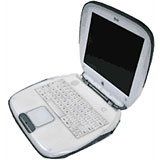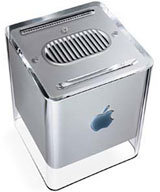At Macworld Expo in January 2000, Steve Jobs announced he would no
longer be interim CEO, that Mac OS X Client would be finished before
Macworld Expo in January 2001, and no new hardware.
We did see new portable Macs in February, notably the 'Pismo' PowerBook. Pismo came
in 400 and 500 MHz models, added FireWire ports, and eliminated the
SCSI port found on all previous PowerBooks. It was the first PowerBook
to support up to 1 GB of RAM, and there have even been G4 upgrades for
it. Many consider Pismo the pinnacle of PowerBook design.
 Apple also boosted base
memory in the iBook
from 32 MB to 64 MB and introduced the graphite 366 MHz iBook Special Edition.
Apple also boosted base
memory in the iBook
from 32 MB to 64 MB and introduced the graphite 366 MHz iBook Special Edition.
But perhaps the biggest news in February was the availability of the
500 MHz Power Macintosh
G4, a product first announced in August 1999.
Macworld New York
 There were no
new product announcements until the July Macworld Expo in New York,
where Apple made no changes to the portable line while overhauling the
desktop line.
There were no
new product announcements until the July Macworld Expo in New York,
where Apple made no changes to the portable line while overhauling the
desktop line.
The big news was the
Cube, properly known as the Power Mac (not Macintosh) G4 Cube.
Inside a transparent 581 cubic inch case Apple stuffed a DVD-ROM drive,
a hard drive, an AGP video card, space for 1.5 GB of memory, an AirPort
antenna and room for an AirPort card, a v.90 modem, USB and FireWire
ports, a 450 or 500 MHz G4 processor, and a brand new connector to both
power and display images on Apple's newest monitors.
Two Brains Are Better than One
The 'Sawtooth' Power Macintosh G4 was discontinued at 450 and 500
MHz, replaced by the
dual-processor 'Mystic' model (often called 'Gigabit Ethernet'
models, they were the first Macs to support 100 Mbps ethernet) with no
increase in price.
Although Apple pomoted the new Macs using the slogan "two brains are
better than one", the reality was the the Classic Mac OS was unable to
take advantage of the second CPU - and very few programs could either.
(Photoshop was an exception.)
 The
biggest changes were reserved for the iMac. Apple abandoned "fruity"
blueberry, grape, strawberry, lime, and tangerine for a new spectrum of
colors. The basic iMac
had the same specifications as the 350 MHz blueberry entry level
model, but came in indigo and sold for $799, $200 less than the old one
(it didn't ship until September).
The
biggest changes were reserved for the iMac. Apple abandoned "fruity"
blueberry, grape, strawberry, lime, and tangerine for a new spectrum of
colors. The basic iMac
had the same specifications as the 350 MHz blueberry entry level
model, but came in indigo and sold for $799, $200 less than the old one
(it didn't ship until September).
The new iMac DV
ran at 400 MHz, just like the earlier iMac DV, but it no longer
included a DVD-ROM drive. The DV had a CD-ROM drive and came in indigo
or ruby at a $999 price.
 Next up the line was the iMac DV+, which replaced the
previous iMac DV feature-for-feature, but with a 450 MHz processor. In
addition to ruby and indigo, the $1,299 DV+ was also available in sage.
It was the only iMac ever available in that color.
Next up the line was the iMac DV+, which replaced the
previous iMac DV feature-for-feature, but with a 450 MHz processor. In
addition to ruby and indigo, the $1,299 DV+ was also available in sage.
It was the only iMac ever available in that color.
At the top of the iMac line was the new iMac Special Edition. The 500 MHz processor was
25% faster than the previous generation iMac SE, and it was available
in both the older graphite and a new white finish called snow.
Mac OS X Public Beta
The biggest change since Apple returned to profitability was the
better-late-than-never public beta release of Mac OS X (billed as a
"preview" release) on Sept. 13. Mac users could pay $30 and get an
advance look at Apple's next generation OS - and report bugs, make
suggestions, etc.
I bought a copy of the Beta and installed it on an external drive
attached to the Power Mac G4 at work. I dabbled with it a bit just to
see what it was about, but never used it for production. Minimum
hardware requirements for the Beta include a G3 CPU, 128 MB of RAM, and
1.5 GB of hard drive space. It expired on May 15, 2001, and purchasers
were entitled to a $30 discount when buying the release version of OS X
from Apple.
We never really covered it on Low End Mac. The best
review of the Public Beta came from John Siracusa at Ars Technica,
who warned, "for $29.95 you get an unfinished, buggy version of Apple's
next generation operating system." It was definitely rough around the
edges, and Apple paid attention to many user suggestions in creating
the first commercial release of OS X in 2001.
Clamshell, the Next Generation
On the same day it announced the Beta, Apple unveiled new versions
of the clamshell iBooks. The new models used the PowerPC 750cx CPU,
which has an onboard 256 KB level 2 cache. In terms of features, the
big addition was a FireWire port. The new models included an
entry-level 366 MHz
iBook in indigo or Key lime and a faster 466 MHz iMac SE in graphite
or Key lime. The latter also included a DVD-ROM drive.
The Competition
This was the year the PC world reached the 1 GHz mark, first with
the AMD Athlon and later with Intel's Pentium III. Windows 2000 shipped
in February.
Next - 2001: OS X, Titanium PowerBook, Spotted
iMacs, Faster Power Macs, White iBooks, and the iPod

 Apple also boosted base
memory in the
Apple also boosted base
memory in the  There were no
new product announcements until the July Macworld Expo in New York,
where Apple made no changes to the portable line while overhauling the
desktop line.
There were no
new product announcements until the July Macworld Expo in New York,
where Apple made no changes to the portable line while overhauling the
desktop line. The
biggest changes were reserved for the iMac. Apple abandoned "fruity"
blueberry, grape, strawberry, lime, and tangerine for a new spectrum of
colors. The
The
biggest changes were reserved for the iMac. Apple abandoned "fruity"
blueberry, grape, strawberry, lime, and tangerine for a new spectrum of
colors. The  Next up the line was the
Next up the line was the 
